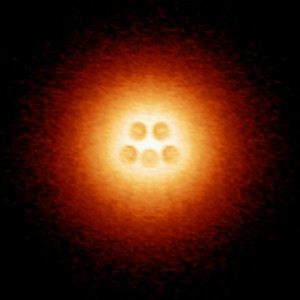 |
| An artificial atomic nucleus made up of five charged calcium dimmers is centered in an atomic-collapse electron cloud (Image courtesy of Michael Crommie) |
The first experimental observation of a quantum mechanical phenomenon that was predicted nearly 70 years ago holds important implications for the future of graphene-based electronic devices. Working with microscopic artificial atomic nuclei fabricated on graphene, a collaboration of researchers led by scientists with the U.S. Department of Energy’s Lawrence Berkeley National Laboratory (Berkeley Lab) and the University of California (UC) Berkeley have imaged the “atomic collapse” states theorized to occur around super-large atomic nuclei.
“Atomic collapse is one of the holy grails of graphene research, as well as a holy grail of atomic and nuclear physics,” says Michael Crommie, a physicist who holds joint appointments with Berkeley Lab’s Materials Sciences Division and UC Berkeley’s Physics Department. “While this work represents a very nice confirmation of basic relativistic quantum mechanics predictions made many decades ago, it is also highly relevant for future nanoscale devices where electrical charge is concentrated into very small areas.”
Crommie is the corresponding author of a paper describing this work in the journal Science. The paper is titled “Observing Atomic Collapse Resonances in Artificial Nuclei on Graphene.” Co-authors are Yang Wang, Dillon Wong, Andrey Shytov, Victor Brar, Sangkook Choi, Qiong Wu, Hsin-Zon Tsai, William Regan, Alex Zettl, Roland Kawakami, Steven Louie, and Leonid Levitov.
Originating from the ideas of quantum mechanics pioneer Paul Dirac, atomic collapse theory holds that when the positive electrical charge of a super-heavy atomic nucleus surpasses a critical threshold, the resulting strong Coulomb field causes a negatively charged electron to populate a state where the electron spirals down to the nucleus and then spirals away again, emitting a positron (a positively–charged electron) in the process. This highly unusual electronic state is a significant departure from what happens in a typical atom, where electrons occupy stable circular orbits around the nucleus.
Berkley Lab News: Long Predicted Atomic Collapse State Observed in Graphene
Comments